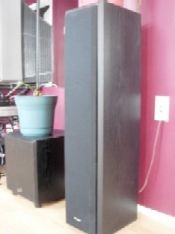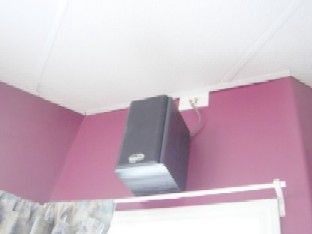
Wiring

Electric Code
The Electric Code is separate from the Building Code. For the residential construction the Simplified Electric Code is preferred as it only has information that is applicable to residential wiring.
All electrical house
After studing the Simplified Electrical Code during winter time, I came up with my wiring diagrams:
The house was all electrical, no gas. I analyzed prices for gas and electricity over extended period of time and noticed that the gas prices had been steadily going up, while the electricity prices down. The explanation was simple. Fossil fuel was getting more and more expensive because it had being exhausted. Due to different ways of producing electricity and competition among them, the electricity prices had always been going down.
Despite of the fact that electrical heating today is still slightly more expensive than gas, this was going to change soon.

Advantages of all electrical house
Safety
There is no explosive suffocative gas in the house. I would sleep much better knowing that there is no risk of an accidental gas leakage.
Electrical baseboard heating
Electrical baseboard heating is quiet and more hygienic than gas forced air circulation type heating. I had been always surprised by the idea of forced air heating vents in a floor where dust was happily collected and then blown around the house by a furnace fan. I certainly wouldn't want to live in such house and breath it. I would rather pay more for electrical heating than for medical expenses caused by inhaling this dust, leaking gas and its by-products escaped from a furnace exhaust system.
Electrical heating is maintenance free. No furnace, no maintenance. No monthly filter replacements, no cleaning or regular inspection, no worries. The electrical baseboards are very cheap, easy to install and control. They do not require any maintenance.

Zoning is much easier to achieve with electrical heating by installing inexpensive programmable thermostats in each room. A controlled temperature in each room allows for more efficient heating.

Tankless water heater
It is also known as an instanteneous water heater. Either term stands for more efficient hot water production. Here are its pros:
- With no tank, there is no stand-by loses. It only heats the amount of water that we consume, not a pint more
- It never runs out of hot water
- A water temperature can be set just right, so no cold water is required to mix with
- When the water temperature is limited and set to warm, there is no risk of getting burned
To be fair, here are its cons:
- Setting a water temperature, in fact, adjusts the heater's power only. The real temperature depends on a water flow. The higher the flow, the lower the temperature and vice versa.
- The above engineering problem results in a slight variation of the water temperature depending on a water pressure. As I describe in Plumbing, my water pressure tank is tuned to 40-60 psi limits. Therefore, when the pressure is near 40 psi, water will be a bit hotter than when the pressure is near 60 psi. The tank's drawdown for the above pressure limits, is 9.3 gallons. Hence, having a shower at 1.5 gallon a minute, one might notice a gradual temperature rise within 6 minutes, then more rapid cooling down as the pump will restore the pressure to 60 psi within less than a minutes.
- Some appliances like a dishwasher or a washing machine, consume water at 3 gallons a minute. If one tunes the water heater for a nice warm shower at 1.5 gallon a minute, which is normally a third bar from the bottom on a regulator, then water will be just lukewarm in those appliances. The appliances that have a heating element will restore the temperature to the required level. Even though mine do, I prefer to bump up the regulator to the top bar for the maximum power. The same principal applies if two showers are needed at the same time.
All this contribute to energy saving and safety.
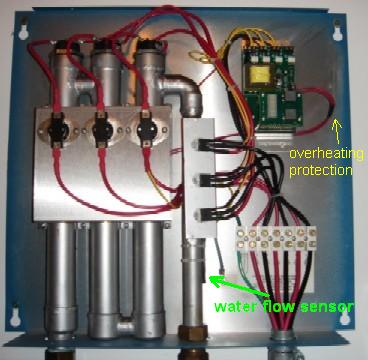
The electric tankless water heaters are less expensive than gas ones and it is much easier to install them.
My unit was made by S.E.T.S., model 240 - the whole house water heater, 24 kW, and therefore, it called for a separate sub-panel with three 40 amp dual pole breakers as it required 240 volt. This subpanel was protected by the 100 amp dual pole breaker in the main panel.
Despite that it used NASA technology and came with the life time warranty on all parts, it didn't turn on all the time. When I called SETS, the technician had authorized me to open the unit to troubleshoot the problem. First, he asked me to remove the aerator in my faucet to provide 3 gpm flow for reliable switching, when according to its specification, it was supposed to be activated at 0.25 gpm. That measure didn't help, of course. Then he asked me to disconnect two wires served the overheating protection. Silly him, it didn't help either. At the end we both gave up.
After that I read SETS patent #6552283 to understand more about the switching mechanism. The patent said that there were three balls inside the intake pipe that had a built-in magnet. When water was turned on, it pushed the balls up in the pipe and the magnet activated the relay. The magnetic field sensitive couple was attached to the pipe with two tie-wraps. I heard the sound of the balls being pushed up, when water was turned on. So it was not the balls. It must have been the sensor. And right I was. All I had to do was to adjust its position on the pipe and I achieved 100% reliable switching. I restored the overheating protection and put back my aerator. The problem was solved. I had not a single problem with this water heater after that.
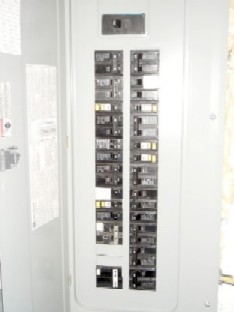
200 amp service
The all electrical house such as mine was impossible to power by a standard 100 amp service. The 200 amp service was required. Initially I had planned to have gas and therefore, I made arrangements for the 100 amp service. To jump to 200 amp, I needed to trench a new cable to the house from the electic pole (4/0 rather than 1/0) and replace the 100 amp meter base with the one that was ceritfied for 200 amp.
I should have planned better. I had to rent an excavator again, buy a new cable and a meter base. The old cable had to be abandoned in the ground.
Wiring
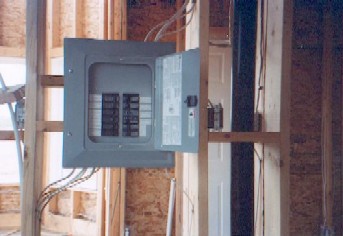
To simplify kitchen wiring I decided to install a subpanel. An electrical range was still supplied with a dual pole 50 amp breaker from the main panel in the utility room according to the Code.
Breakers
All bathrooms and outside circuits were protected with GFCI breakers. All bedrooms with arc-fault breakers, again as per the Code requirements.
As you see, my 40 breaker main panel is almost full and some breakers are so called space savers meaning that there are two breakers in a standard single breaker socket.

Ceiling lights
I like light. And like it a lot. All rooms were wired for ceiling lights. Some rooms had even a few of them. Suspended ceiling was of course, the major convenience for hanging light fixtures and pulling wires. It is easy to change the lighting later. No major renovation is required for such job. In the worst case, one just need to relpace a ceiling panel but this is not the expensive item. Read more about suspended paneling in the "Ceiling" chapter.
Low voltage wiring

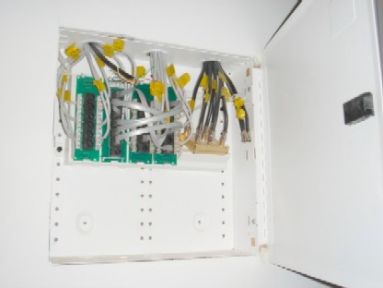
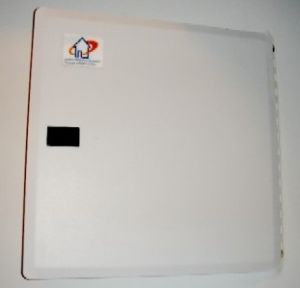
Telephone, Network and Video

I pre-wired all rooms with telephone CAT-5e, ethernet network CAT-5e and coaxial video cables. In utility room I installed a nice Leviton communication panel.
Sooner after the house construction was finished, I installed a Bell Vu Express satellite dish. This dish is elliptical, has two LNBs and receives signals from two satellites: EchoStar 110° and 82°.
High speed Internet
High speed Internet became a commodity and now even available on acreages. No, it's not ADSL or cable, it is wireless. The antenna looks pretty much like a satellite dish except it points to an ISP provider tower rather than a satellite. People who are interested in this topic can get more details on Cruz Internet Services web site.
Dolby Digital Surround Sound
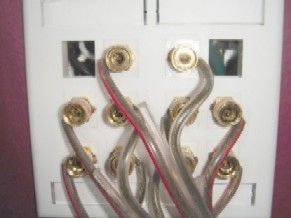

I wired the living room with a 5-channel dolby surround system. I think it is much better than cords and cables hanging around everywhere.
